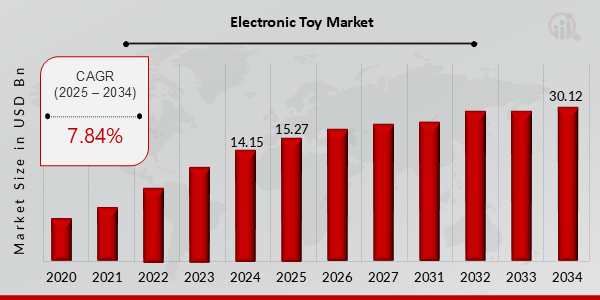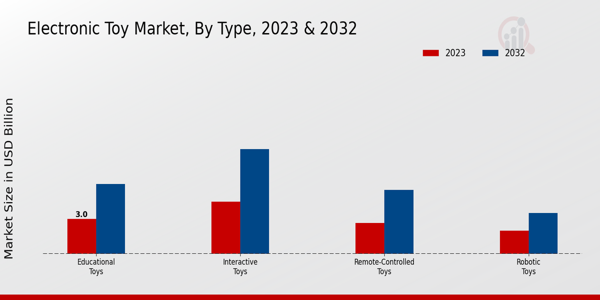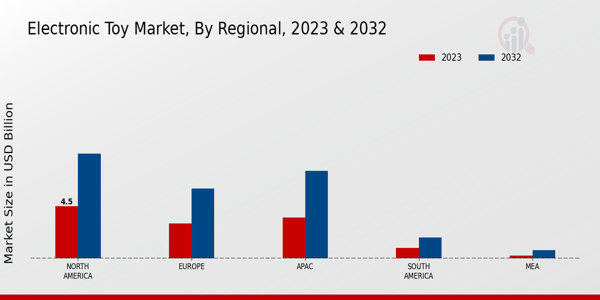Global Electronic Toy Market Overview
Electronic Toy Market Size was estimated at 14.15 (USD Billion) in 2024. The Electronic Toy Market Industry is expected to grow from 15.27 (USD Billion) in 2025 to 30.12 (USD Billion) till 2034, exhibiting a compound annual growth rate (CAGR) of 7.84% during the forecast period (2025 - 2034)
Key Electronic Toy Market Trends Highlighted
The Electronic Toy Market is experiencing a notable shift due to several key market drivers. Increasing smartphone penetration and the rise of internet connectivity have greatly influenced children's play patterns. Parents are more inclined to invest in electronic toys that offer educational content, fostering learning in an engaging way. Additionally, the growing demand for interactive and immersive experiences plays a significant role in shaping the market. As manufacturers increasingly integrate technology into toys, they are able to capture children's attention more effectively, promoting extended playtime and stimulating cognitive development. There are numerous opportunities to be explored in this marketplace. As awareness of the benefits of electronic toys rises, there is a growing market for products that combine play with educational value. Companies can diversify their offerings by developing smart toys that can adapt to the child's learning pace, thereby enhancing the user experience. The trend toward sustainability also presents a chance to create eco-friendly electronic toys that appeal to environmentally conscious consumers. Moreover, the expansion of e-commerce channels provides a wider reach for these products, allowing brands to connect with a global audience. Recent trends indicate a shift toward personalization and customization in electronic toys.
Manufacturers are increasingly offering products that allow children to engage in creative activities and personalize their experiences. The rise of augmented reality and virtual reality is also a significant trend, transforming traditional play into more engaging and interactive experiences. These technologies allow children to explore new environments and scenarios, thereby enhancing their overall play experience. As the market continues to evolve, staying attuned to these trends will be crucial for stakeholders aiming to capitalize on emerging opportunities and effectively meet consumer demands.

Source: Primary Research, Secondary Research, MRFR Database and Analyst Review
Electronic Toy Market Drivers
Increasing Adoption of Technology in Toys
The Electronic Toy Market Industry is experiencing a significant rise due to the increasing adoption of technology in toys. As more children spend time interacting with digital devices, toy manufacturers are integrating advanced technologies such as artificial intelligence, augmented reality, and interactive features into their products. This technological enhancement not only makes toys more engaging but also promotes learning and development among children. Parents are increasingly seeking educational value in toys, which has led to the creation of electronic toys that bolster cognitive skills, problem-solving abilities, and creativity. The trend of incorporating technology into traditional toys aligns with the modern lifestyle of children who are accustomed to using gadgets from an early age. As the demand for innovative products rises, manufacturers are continuously developing new electronic toys that capture the interest of young consumers and encourage them to develop essential skills in a fun and interactive way. Additionally, the availability of these advanced electronic toys through e-commerce platforms is further driving market growth by providing easier access to a larger audience. The versatile nature of electronic toys, which can be used both for play and learning, positions them as an appealing choice for parents looking to combine entertainment with education. This strong focus on technology in the Electronic Toy Industry is expected to propel further advancements in product design and functionality, catering to the evolving preferences of children and parents alike.
Rising Disposable Income and Changing Lifestyles
Another significant driver for the Electronic Toy Market Industry is the rising disposable income and changing lifestyles of consumers. As more families experience financial growth, they are more willing to spend on quality entertainment for their children, leading to increased purchases of electronic toys. In many households, parents place a high value on providing their children with products that foster creativity and educational growth. This willingness to invest in better-quality toys is driving the demand for innovative electronic options. In addition, changing lifestyles often reflect a growing inclination towards technology and online engagement. This cultural shift has encouraged parents to seek electronic toys that not only entertain but also provide valuable learning experiences, further propelling the market's expansion.
Expansion of E-Commerce and Retail Platforms
The expansion of e-commerce and retail platforms is a significant market driver for the Electronic Toy Market Industry. With the rise of online shopping, consumers have greater access to a wide variety of electronic toys, ranging from educational games to high-tech gadgets. This accessibility makes it easier for parents to compare products, read reviews, and make informed purchasing decisions. The ability to shop from home has become particularly appealing during times when physical retail experiences may be restricted or less desirable. Furthermore, many retailers are launching targeted marketing campaigns through digital platforms, which cater specifically to tech-savvy consumers looking to invest in innovative toys. As a result, the reach and visibility of electronic toys have expanded, making it easier for manufacturers to connect with potential customers and drive sales.
Electronic Toy Market Segment Insights:
Electronic Toy Market Type Insights
The Electronic Toy Market is experiencing significant growth, driven by diverse types of products that cater to varying consumer preferences and demands. In 2023, the market was valued at 12.17 USD Billion, reflecting a robust interest in electronic toys among consumers. The segmentation of the market by type showcases distinct subcategories, primarily Educational Toys, Interactive Toys, Remote-Controlled Toys, and Robotic Toys. Within these categories, Educational Toys are emerging as a significant force, with a market valuation of 3.0 USD Billion in 2023, projected to double to 6.0 USD Billion by 2032. This growth is attributed to the increasing emphasis on STEM education, making these toys not only entertaining but also instrumental in the early learning stages of children.
Interactive Toys also play a crucial role in the market dynamics, with a valuation of 4.5 USD Billion in 2023 and expected to grow to 9.0 USD Billion by 2032. The appeal of these toys lies in their ability to engage children in active play, fostering developmental skills such as communication and social interaction. They often employ technology that encourages children to interact, learn, and explore their environment, hence gaining a significant share of investor interest. Remote-controlled toys account for a market value of 2.67 USD Billion in 2023 and are anticipated to reach 5.5 USD Billion by 2032. Their importance stems from the timeless appeal they hold among various age groups, encouraging outdoor play and physical activity, which is increasingly valued in a digitalized world.
The hands-on experience provided by these toys can enhance motor skills and coordination. Lastly, Robotic Toys, while currently valued at 2.0 USD Billion in 2023 with projections of 3.5 USD Billion by 2032, are gaining traction as technology evolves. These toys offer children an introduction to robotics and programming concepts, which are critical in fostering STEM competencies. Although they currently represent a smaller market share compared to Educational and Interactive Toys, their significance is growing due to rising trends in robotics education and innovation.
Overall, the Electronic Toy Market segmentation reveals that Educational and Interactive Toys dominate the industry, supported by their robust growth rates. As the market expands, these segments highlight a shift towards incorporating educational value in play while also ensuring that children's interaction with technology remains engaging and beneficial. The evolving landscape of the electronic toy industry illustrates a promising future that is driven by innovation and a greater focus on education in entertainment.

Source: Primary Research, Secondary Research, MRFR Database and Analyst Review
Electronic Toy Market Age Group Insights
Electronic Toy MarketThis market segmentation highlights four key age groups: Infants, Toddlers, Preschoolers and school-age children. Each group plays a crucial role in shaping market trends as they demand innovative and engaging electronic toys that support developmental milestones. Infants and Toddlers prioritize toys that enhance sensory experiences, while Preschoolers focus on educational and imaginative play. School-age children increasingly lean towards interactive and multi-functional toys that blend entertainment and learning. Collectively, these segments contribute to the extensive Electronic Toy Market revenue. Furthermore, the market growth is driven by rising disposable incomes, technological advancements, and the growing inclination of parents toward educational products. However, challenges such as safety concerns and competitive pricing persist. Overall, the Electronic Toy Market Statistics reflect a robust framework for consumer preferences, indicating a progressive trajectory from 2024 to 2032.
Electronic Toy Market Sales Channel Insights
Electronic Toy MarketThe segmentation showcases a variety of avenues for distribution, with Online Retail experiencing significant growth due to its convenience and wide reach, making it a preferred choice among consumers. Supermarkets contribute to the market by offering instant accessibility and exposure to a broad demographic, while Specialty Stores create an immersive shopping experience through expert knowledge and unique offerings. Toy Stores traditionally dominate the market due to established branding and targeted customer engagement, which enhances their relevance. Each channel plays a pivotal role in shaping consumer purchasing behavior and overall market growth, providing a well-rounded approach to accessing the vast array of products in the Electronic Toy Market. This market is influenced by trends such as the rise in digital play and experiential shopping, driving the demand for electronic toys across these varied channels. Moreover, as the market evolves, challenges like supply chain disruptions and shifting consumer preferences continue to influence how these channels operate, presenting both obstacles and opportunities in the Electronic Toy Market.
Electronic Toy Market Features Insights
Electronic Toy MarketAs part of this dynamic market, features such as Bluetooth Connectivity, Voice Recognition, Augmented Reality, and Developmental Learning play a pivotal role in enhancing consumer engagement and user experience. Bluetooth Connectivity has become increasingly vital, allowing toys to connect to mobile devices and integrating play with digital applications. Voice Recognition technology empowers toys to interact with children in a more personalized manner, which fosters learning and development. Augmented Reality (AR) continues to gain traction, offering immersive experiences that bridge the gap between digital content and physical play, appealing primarily to tech-savvy consumers. Lastly, Developmental Learning features are significant, as they align toys with educational objectives, appealing to parents seeking enriching experiences for their children. The increasing incorporation of these advanced features underscores the innovation within the Electronic Toy Market industry, driving market growth through enhanced functionality and interactive learning experiences. This segmentation provides valuable insights into the market landscape, highlighting opportunities for manufacturers to create differentiated products that resonate with both children and parents.
Electronic Toy Market Regional Insights
The Electronic Toy Market is poised for significant growth across various regions, reflecting diverse consumer preferences and market dynamics. In 2023, the North America market was valued at 4.5 USD Billion, and it is anticipated to gain substantial traction, reflecting its majority holding in the market's overall valuation. Europe's valuation stood at 3.0 USD Billion, showing its significant presence, driven by advancements in technology and high demand for innovative toys. The APAC region, valued at 3.5 USD Billion in 2023, is rapidly emerging as a crucial market due to its large population and increasing adoption of electronic toys. South America and MEA, although smaller markets with valuations of 0.9 USD Billion and 0.27 USD Billion, respectively, are witnessing growth opportunities fueled by rising disposable incomes and the expansion of product offerings. Understanding the Electronic Toy Market segmentation illuminates key trends, such as the increasing integration of educational features and sustainability in product design, which are shaping the industry's future landscape.

Source: Primary Research, Secondary Research, MRFR Database and Analyst Review
Electronic Toy Market Key Players and Competitive Insights:
The Electronic Toy Market is characterized by rapid innovation and a continually evolving landscape, driven by technological advancements and shifting consumer preferences. As the digital generation drives the demand for interactive and educational toys, manufacturers are increasingly focusing on creating products that combine entertainment with learning. Competition in this market is fierce, with numerous players seeking to capture market share through unique features, branding strategies, and the integration of advanced technologies. The market is influenced by factors such as changing demographics, the growing prevalence of smart devices, and a heightened focus on the developmental benefits of electronic toys. Companies are also leveraging partnerships with educational institutions and tech innovators to enhance their offerings and establish a competitive edge. FisherPrice has positioned itself as a leading player in the Electronic Toy Market by focusing on early childhood development and interactive learning experiences. The strength of FisherPrice lies in its deep understanding of child development principles and a commitment to integrating these insights into the design of their toys. Their products often include interactive features, engaging content, and various educational themes that appeal to both parents and children. FisherPrice has maintained a strong brand identity over the years thanks to its consistent emphasis on safety, quality, and innovative play patterns. This established credibility and reputation in the market allows FisherPrice to attract and retain a loyal customer base, fostering strong connections with families seeking to offer educational play opportunities. Furthermore, FisherPrice's strategic collaborations with educational content providers ensure that their toys remain relevant and effective in enhancing learning outcomes, solidifying their presence in this highly competitive sector.
Microsoft has ventured into the Electronic Toy Market by bringing its technological expertise and innovative approach to the realm of interactive play. The company is recognized for its ability to integrate software with hardware, creating unique electronic toys that often emphasize STEM (Science, Technology, Engineering, and Mathematics) education. Microsoft's strengths lie in its vast research and development capabilities, allowing for the continuous introduction of cutting-edge products that resonate with tech-savvy consumers. The company benefits from a strong brand presence and trust amongst users, enabling it to fuse entertainment with educational value effectively. Further, Microsoft has a forward-thinking strategy to leverage its existing platforms and ecosystems, such as cloud services and gaming, to enhance the interactivity and user experience of electronic toys. This diversification not only appeals to children but also entices parents who prioritize educational benefits. As a result, Microsoft’s innovative approach adds a unique dimension to the electronic toy segment, providing competitive insights into the amalgamation of education and technology in play.
Key Companies in the Electronic Toy Market Include:
- FisherPrice
- Microsoft
- Spin Master
- LEGO
- Playmobil
- Sega
- Bandai Namco
- Sony
- Nintendo
- VTech
- TOMY
- ZURU
- Mattel
- Ravensburger
- Hasbro
Electronic Toy Industry Developments
In recent months, the Electronic Toy Market has witnessed significant developments driven by technological advancements and shifting consumer preferences. Companies like LEGO and Spin Master are expanding their product lines with interactive and educational toys, targeting a growing demand for STEM-related play experiences. Additionally, Bandai Namco and Hasbro have been enhancing their gaming portfolios, introducing new digital and augmented reality features aimed at engaging younger audiences. Notably, FisherPrice is expanding its presence in the smart toy sector, catering to tech-savvy parents seeking developmental tools for their children. In terms of mergers and acquisitions, there has been increased activity as companies seek synergies to bolster their market positions. For example, recent acquisitions by TOMY aim to integrate innovative technologies into their traditional toy offerings. Meanwhile, VTech has been actively pursuing collaborations with gaming giants like Sega and Nintendo to enhance their digital toy capabilities. The market is experiencing growth in valuation as these companies adapt to the evolving landscape, which is enhancing competition and leading to inventive product offerings across the board.
Electronic Toy Market Segmentation Insights
-
Electronic Toy Market Type Outlook
- Educational Toys
- Interactive Toys
- Remote-Controlled Toys
- Robotic Toys
-
Electronic Toy Market Age Group Outlook
- Infants
- Toddlers
- Preschoolers
- School Age
-
Electronic Toy Market Sales Channel Outlook
- Online Retail
- Supermarkets
- Specialty Stores
- Toy Stores
-
Electronic Toy Market Features Outlook
- Bluetooth Connectivity
- Voice Recognition
- Augmented Reality
- Developmental Learning
-
Electronic Toy Market Regional Outlook
- North America
- Europe
- South America
- Asia Pacific
- Middle East and Africa
|
Report Attribute/Metric
|
Details
|
|
Market Size 2024
|
USD 14.15 Billion
|
|
Market Size 2025
|
USD 15.27 Billion
|
|
Market Size 2034
|
USD 30.12 Billion
|
|
Compound Annual Growth Rate (CAGR)
|
7.84% (2025-2034)
|
|
Base Year
|
2024
|
|
Market Forecast Period
|
2025-2034
|
|
Historical Data
|
2020-2023
|
| Market Forecast Units |
USD Billion |
| Key Companies Profiled |
FisherPrice, Microsoft, Spin Master, LEGO, Playmobil, Sega, Bandai Namco, Sony, Nintendo, VTech, TOMY, ZURU, Mattel, Ravensburger, Hasbro |
| Segments Covered |
Type, Age Group, Sales Channel, Features, Regional |
| Key Market Opportunities |
Increased demand for educational toys, Integration of AR/VR technology, Expansion into emerging markets, Sustainable and eco-friendly materials, Growth in online retail channels |
| Key Market Dynamics |
Technological advancements, Rising disposable income, Increasing demand for educational toys, Growing influence of social media, Product innovation and diversification |
| Countries Covered |
North America, Europe, APAC, South America, MEA |
Frequently Asked Questions (FAQ) :
The Electronic Toy Market is expected to be valued at 30.12 USD Billion in 2034.
The projected CAGR for the Electronic Toy Market from 2025 to 2034 is 7.84%.
By 2032, North America is expected to dominate the Electronic Toy Market with a value of 9.0 USD Billion.
The market size for Educational Toys is projected to reach 6.0 USD Billion in 2032.
Major players in the market include FisherPrice, Microsoft, Spin Master, LEGO, and Playmobil.
The expected market size for Interactive Toys is 9.0 USD Billion by 2032.
Remote-Controlled Toys are estimated to reach a market size of 5.5 USD Billion in 2032.
The market size for Robotic Toys is valued at 2.0 USD Billion in 2023.
The APAC region is expected to grow to 7.5 USD Billion in the Electronic Toy Market by 2032.
Challenges that could impact growth may include changes in consumer preferences and supply chain disruptions.

















